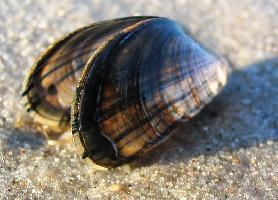
Poids et mesures
| Longueur | 12 cm |
|---|
Description de l'animal
The Blue mussel (Mytilus edulis) is a fascinating marine bivalve mollusk belonging to the family Mytilidae. Often found clinging in dense clusters to rocks and other hard substrates along the temperate and cold coastal waters of the North Atlantic, this species plays a crucial role in its ecosystem. Not only does it serve as a vital food source for a variety of predators, including birds, sea stars, and humans, but it also contributes significantly to water filtration and habitat structure.Physically, the Blue mussel boasts a distinctive appearance. Its shell, which can reach lengths of up to 10 centimeters though commonly found smaller, is elongated and asymmetrical. The outer surface of the shell exhibits a blue-black to dark purple coloration, while the interior shines with a pearly hue. This shell is not only a protective barrier against predators and environmental stressors but also a fascinating example of natural engineering, designed to withstand the constant battering of waves and currents.
One of the most intriguing aspects of the Blue mussel's biology is its method of attachment. The mussel secretes strong, silky threads known as byssal threads, which it uses to anchor itself securely to surfaces. This adaptation is crucial for its survival in the intertidal zone, a harsh and dynamic environment where the mussel must withstand both the pounding of waves and the risk of desiccation during low tides.
Blue mussels are filter feeders, playing a pivotal role in their ecosystems by purifying the water. They draw in water through their gills, trapping plankton and other small particles, which are then ingested. This process not only nourishes the mussel but also helps maintain the clarity and quality of the coastal waters. A single Blue mussel can filter several liters of water per hour, highlighting its importance in the ecosystem.
Reproduction in Blue mussels is another area of interest. They are dioecious, with separate male and female individuals, and reproduction occurs through the release of sperm and eggs into the water column. This spawning event, which typically takes place between spring and summer, results in the fertilization of eggs and the development of planktonic larvae. These larvae drift in the plankton for several weeks before settling and metamorphosing into juvenile mussels, starting the cycle anew.
The economic importance of the Blue mussel cannot be overstated. It is a highly valued seafood species, farmed extensively in many parts of the world for its delicate flavor and nutritional value. Mussel farming is considered environmentally sustainable, as it does not require feed inputs and can actually improve water quality through the mussels' filtration activities.
However, the Blue mussel faces several challenges, including habitat loss, pollution, and the impacts of climate change. Rising ocean temperatures and acidification pose significant threats to mussel populations by affecting their growth and survival. Additionally, the introduction of invasive species can lead to competition for space and resources, further stressing native mussel populations.
In conclusion, the Blue mussel is a remarkable creature with a complex biology and significant ecological and economic roles. Its ability to adapt to the challenging conditions of the intertidal zone, combined with its contributions to marine ecosystems and human cuisine, make it a species of great interest and importance. Conservation efforts are essential to ensure the sustainability of Blue mussel populations and the continued health of coastal ecosystems.
Nouvelles photos d'animaux
Top 10 des animaux
- Dolphin gull (Leucophaeus scoresbii)
- Diana monkey (Cercopithecus diana)
- Moustached guenon (Cercopithecus cephus)
- Galápagos tortoise (Geochelone nigra complex)
- Russian tortoise (Testudo horsfieldii)
- Japanese macaque (Macaca fuscata)
- Stone loach (Barbatula barbatula)
- Greek tortoise (Testudo graeca)
- Common flying dragon (Draco volans)
- Colossal squid (Mesonychoteuthis hamiltoni)